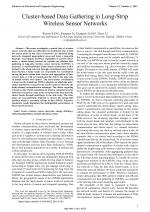| 1/2012 - 1 | View TOC | « Previous Article | Next Article » |
Cluster-based Data Gathering in Long-Strip Wireless Sensor NetworksFANG, W. |
| Extra paper information in |
| Click to see author's profile in |
| Download PDF |
Author keywords
wireless sensor networks, energy efficiency, clustering algorithms, channel allocation, relay
References keywords
sensor(20), networks(17), systems(4), protocol(4), network(4), energy(4)
Blue keywords are present in both the references section and the paper title.
About this article
Date of Publication: 2012-02-28
Volume 12, Issue 1, Year 2012, On page(s): 3 - 8
ISSN: 1582-7445, e-ISSN: 1844-7600
Digital Object Identifier: 10.4316/AECE.2012.01001
Web of Science Accession Number: 000301075000001
SCOPUS ID: 84860754985
Abstract
This paper investigates a special class of wireless sensor networks that are different from traditional ones in that the sensor nodes in this class of networks are deployed along narrowly elongated geographical areas and form a long-strip topology. According to hardware capabilities of current sensor nodes, a cluster-based protocol for reliable and efficient data gathering in long-strip wireless sensor networks (LSWSN) is proposed. A well-distributed cluster-based architecture is first formed in the whole network through contention-based cluster head election. Cluster heads are responsible for coordination among the nodes within their clusters and aggregation of their sensory data, as well as transmission the data to the sink node on behalf of their own clusters. The intra-cluster coordination is based on the traditional TDMA schedule, in which the inter-cluster interference caused by the border nodes is solved by the multi-channel communication technique. The cluster reporting is based on the CSMA contention, in which a connected overlay network is formed by relay nodes to forward the data from the cluster heads through multi-hops to the sink node. The relay nodes are non-uniformly deployed to resolve the energy-hole problem which is extremely serious in the LSWSN. Extensive simulation results illuminate the distinguished performance of the proposed protocol. |
| References | | | Cited By |
Web of Science® Times Cited: 9 [View]
View record in Web of Science® [View]
View Related Records® [View]
Updated today
SCOPUS® Times Cited: 11
View record in SCOPUS® [Free preview]
View citations in SCOPUS® [Free preview]
[1] MAC Protocol for Data Gathering in Wireless Sensor Networks with the Aid of Unmanned Aerial Vehicles, VLADUTA, A.-V., PURA, M. L., BICA, I., Advances in Electrical and Computer Engineering, ISSN 1582-7445, Issue 2, Volume 16, 2016.
Digital Object Identifier: 10.4316/AECE.2016.02007 [CrossRef] [Full text]
[2] HIGH: A Hexagon-based Intelligent Grouping Approach in Wireless Sensor Networks, FAN, C.-S., Advances in Electrical and Computer Engineering, ISSN 1582-7445, Issue 1, Volume 16, 2016.
Digital Object Identifier: 10.4316/AECE.2016.01006 [CrossRef] [Full text]
[3] Rich: Region-based Intelligent Cluster-Head Selection and Node Deployment Strategy in Concentric-based WSNs, FAN, C.-S., Advances in Electrical and Computer Engineering, ISSN 1582-7445, Issue 4, Volume 13, 2013.
Digital Object Identifier: 10.4316/AECE.2013.04001 [CrossRef] [Full text]
[4] Energy-efficient clustering method for wireless sensor networks using modified gravitational search algorithm, Ebrahimi Mood, Sepehr, Javidi, Mohammad Masoud, Evolving Systems, ISSN 1868-6478, Issue 4, Volume 11, 2020.
Digital Object Identifier: 10.1007/s12530-019-09264-x [CrossRef]
[5] An efficient intelligent clustering scheme in dynamic networks, Amirshahi, Bita, Amirshahi, Seyed Amin, 2015 International Congress on Technology, Communication and Knowledge (ICTCK), ISBN 978-1-4673-9762-9, 2015.
Digital Object Identifier: 10.1109/ICTCK.2015.7582701 [CrossRef]
Disclaimer: All information displayed above was retrieved by using remote connections to respective databases. For the best user experience, we update all data by using background processes, and use caches in order to reduce the load on the servers we retrieve the information from. As we have no control on the availability of the database servers and sometimes the Internet connectivity may be affected, we do not guarantee the information is correct or complete. For the most accurate data, please always consult the database sites directly. Some external links require authentication or an institutional subscription.
Web of Science® is a registered trademark of Clarivate Analytics, Scopus® is a registered trademark of Elsevier B.V., other product names, company names, brand names, trademarks and logos are the property of their respective owners.
Faculty of Electrical Engineering and Computer Science
Stefan cel Mare University of Suceava, Romania
All rights reserved: Advances in Electrical and Computer Engineering is a registered trademark of the Stefan cel Mare University of Suceava. No part of this publication may be reproduced, stored in a retrieval system, photocopied, recorded or archived, without the written permission from the Editor. When authors submit their papers for publication, they agree that the copyright for their article be transferred to the Faculty of Electrical Engineering and Computer Science, Stefan cel Mare University of Suceava, Romania, if and only if the articles are accepted for publication. The copyright covers the exclusive rights to reproduce and distribute the article, including reprints and translations.
Permission for other use: The copyright owner's consent does not extend to copying for general distribution, for promotion, for creating new works, or for resale. Specific written permission must be obtained from the Editor for such copying. Direct linking to files hosted on this website is strictly prohibited.
Disclaimer: Whilst every effort is made by the publishers and editorial board to see that no inaccurate or misleading data, opinions or statements appear in this journal, they wish to make it clear that all information and opinions formulated in the articles, as well as linguistic accuracy, are the sole responsibility of the author.



